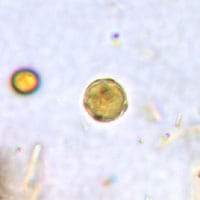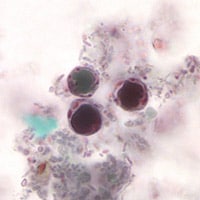
Monthy Case Studies - 2002
Case #93 - October, 2002
A stool specimen from a 61-year-old man was preserved in 10% formalin and PVA for an ova and parasites (O & P) examination. Suspected protozoan cyst-like structures were observed in a hospital laboratory. A portion of the specimen was forwarded to CDC for diagnostic assistance; no clinical or travel information was provided. The following images show what was seen in a wet mount examination of an aliquot from the formalin-ethyl acetate (FEA) concentration (Figure A) and on PVA trichrome stained smears (Figure B). The objects ranged in size from 8 to 14 micrometers in diameter. What is your diagnosis? Based on what criteria?

Figure A

Figure B
Answer to Case #93
This was a case of infection with Blastocystis hominis, a protozoan sometimes found in the intestinal tract of humans (and other animals). The pathogenicity of B. hominis is debatable, yet CDC does report the presence of this organism. Diagnostic features observed included:
- the size of the organism, which was within the range for B. hominis (normal range is 8 to 10 micrometers, but has been reported from 5 to 30 micrometers). Blastocystis shows more variability in size than generally expected for most other ova and parasites.
- the presence of small nuclei within the peripheral ring of cytoplasm. In trichrome stained preparations, these nuclei often appear red.
- the presence of a large, centrally located vacuole or central body. In trichrome stained preparations, this feature appears green to dark purple in color.
More on: Blastocystis hominis
Images presented in the monthly case studies are from specimens submitted for diagnosis or archiving. On rare occasions, clinical histories given may be partly fictitious.
 ShareCompartir
ShareCompartir


